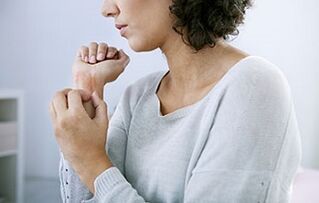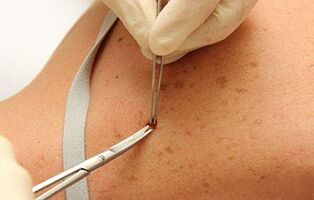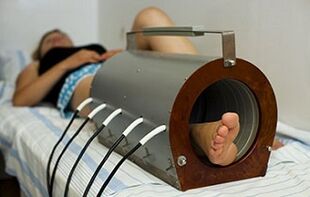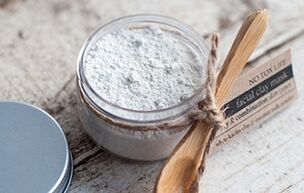Psoriasis is a chronic skin disease. It manifests itself in the form of a rash. The initial stage is characterized by symptoms similar to the clinical manifestations of other pathologies of the epidermis. It is necessary to differentiate the pathology in order to prevent the development of the disease and facilitate its course. To do this, you need to know the symptoms and manifestations of psoriasis at different stages.
Causes in adults and children
The reason why it occurs in children and adults, medical scientists have not yet thought clearly. There is only speculation about the cause of the development of this disease. Thus, there is a hypothesis that psoriasis can be inherited: psoriasis is often observed in people whose parents suffer from such a skin disease. Some doctors link the development of pathology with immunological instability, metabolic diseases and the presence of chronic infection. In most patients, doctors note severe hyperlipidemia.
To test for susceptibility to such a disease, you should perform a classic genome analysis. Those with ten chromosome loci are more likely to develop psoriasis. The main genome responsible for congenital predisposition is PSORS1.
Psoriasis can develop at any age: in children, young men and women, the elderly. In adults, according to medical scientists, the following factors trigger the disease:
- low immunity;
- chronic fatigue;
- alcohol abuse;
- severe stress;
- poor hygiene;
- permanent overeat;
- insect bite;
- infectious pathologies (influenza, ARVI);
- vaccination;
- temperature difference;
- vitamin deficiency;
- smoking;
- long-term medications;
- burn;
- allergy;
- hormonal imbalance;
- climate change;
- malnutrition.
Children are most prone to psoriatic eruptions:
- after a sore throat;
- if there is a chronic infection in the body;
- low immunity.
Psoriasis should not be started:People with this diagnosis are at increased risk for early atherosclerotic vascular lesions and heart disease. There is also a risk of arthritis.
Most cases of psoriasis occur in people with a weak inheritance.
How psoriasis manifests itself

Psoriasis is characterized by the appearance of large plaques on the skin. The spots are insignificant at first and appear on the parts of the body where the skin is harder (elbows, knees). Such formations sway. Pale scars appear in the morning when scratching.
The disease is characterized by the following manifestations:
- Stearin stain.These are small, scaly papules that have melted into plaques.
- Terminal film.There is a thin, bright pink skin under the psoriatic plaques. The doctor can see after taking all the scales.
- exact bleeding(bloody raw syndrome). If the terminal film is damaged as a result of itching of the stratum corneum of the epidermis, blood droplets appear.
Such manifestations in the aggregate are called psoriatic triad. They are found during a sample of an inflamed skin area.
Psoriasis also has the following symptoms:
- formation of new papules in case of skin damage and enlargement of the lesion area; The elements of the spill have a dense structure;
- There is a red edge around the board;
- weakness;
- the presence of a whitish three-millimeter false atrophic border around the rash;
- purulent odor on the skin (when pustules form);
- the phenomenon of an oily form in which a yellowish-brown spot appears under the nail plate;
- proliferative acanthosis with thickening of the skin, prolonged interpapillary processes;
- high symptom (nail psoriasis);
- itching.
As psoriasis is a chronic pathology, the symptoms begin to disappear after a while and the wounds heal. But then the papules reappear.
The first symptoms of the onset of the disease
In the first stage of psoriasis, there is always a rash.
At first, it is almost invisible without characteristic scales. Several rash spots appear on the extremities.

After a few weeks, the number of affected areas increases. The spill is combined with large plates covered with silver scales. In the early stages of psoriasis, itching is moderate. The person complains of chronic fatigue and weakness.
Such symptoms are also characteristic of allergic skin reactions, dermatitis and itching. Therefore, it is important to make a differential diagnosis.
During the examination, the doctor detects a triad of psoriasis. Depending on the size of the rash, the doctor determines the etiology of psoriasis: in the form of drops, dots or coins.
Signs of a progressive stage of the disease
As the disease progresses, the number of papules increases, and the rash spreads to healthy areas of the body. The slightest scratch, bump, or burn causes a nodular rash. The second stage takes a lot of time. On palpation, you will find tight boundaries between the inflamed areas of the epidermis. The boards have a bright color and an edge covered with scales.
In the final stages of the disease, the symptoms gradually begin to disappear. The boards lighten, the borders fade. After a while, the papules disappear, leaving dry skin and hyperpigmented spots.
The temperature in psoriasis can only rise when an inflammatory process, acne, spreads. Then the affected areas can be damaged.
What is the phenomenon of stearin stain
Stearin spots are the main symptom that makes up the psoriatic trio. It is a small area with papular elements of the rash, heavily scaly. The more the doctor shaves the affected skin, the more the skin peels off. The person does not feel pain during manipulation. Detachable skin flakes are called phenomenon because they look like stearin stains.
Where it first appears: localization of spills
First, psoriasis erupts on the elbows, legs and knees. The papules then spread to areas of the body with thinner and more delicate skin: lower legs, back, wrists, abdomen, groin area, scalp. The rash may be localized elsewhere. These areas of the body are most affected by psoriasis.
In the absence of proper treatment, the disease spreads to the nails, mucous membranes and joints.
The localization of psoriasis in adults may be as follows:
- Head. Rash is observed on the scalp, ears, back of the head, eyebrows, eyelids, eyes, nasolabial folds.
- Lower extremities.
- Elbows. Paid plaques form that become rougher over time.
- Upper limbs. There is little evidence of urticaria.
Rash in children is usually:
appears on- legs;
- hips;
- skin folds;
- elbows;
- scalp.
How to start a paid scalp
Paid lichen can spread throughout the body. It is generally sharp. From a bead to a pea, a rash forms. The papule is covered with silver and white scales. Spills increase in size over time, merging into one focus with uneven edges. The boundaries of this board are clear. When the scalp is affected by psoriasis, a psoriatic crown is formed: purulent red pustules appear behind the ears and along the forehead.
How fast the pathology develops
How fast a pearl develops depends on its shape. Thus, a pathological type in the form of drops is distinguished by its ability to suddenly appear and disappear. Severe plaque psoriasis is characterized by the gradual spread of pustules throughout the body. The rash is then soon covered with bark scales. The debris coalesces to form large plaques.
Diagnostic methods

If you suspect psoriasis, consult a dermatologist. The doctor makes an approximate diagnosis based on complaints and examination of the patient. The doctor gives a recommendation to undergo laboratory, instrumental research. Differential diagnosis is also performed.
If the disease progresses, it is recommended to give blood for analysis to determine an acute, autoimmune or rheumatic process. In severe cases, a biopsy is performed to show accumulation of Rete corpses, layer thickening, polyblasts, T-lymphocytes, skin infiltration with dendritic cells, and increased angiogenesis under psoriatic plaques.
For a differential diagnosis, do the following:
- allergy test;
- serum biochemical test;
- analysis of feces for dysbiosis;
- Histological examination of the biopsy.
Children do not need special tests to diagnose psoriasis. It is detected on the basis of examination of pathological rash elements.
How to treat psoriasis
Psoriasis is considered a chronic disease and cannot be completely cured. The goal of therapy is to achieve a stable remission and eliminate complications. To do this, use drugs, physiotherapy, folk remedies. In severe cases, the patient is hospitalized. At the initial stage, therapy is allowed at home.
Clinic therapy
To treat psoriatic lesions, doctors prescribe antihistamines to relieve swelling, itching and redness.

Enzymatic substances are also used. They stimulate the body to produce the necessary enzymes. Damage to the skin of the body causes discomfort, compression.
An illness causes psychological problems that cannot be cured. Therefore, doctors prescribe sedatives to help restore the emotional state.
Hepatoprotectors are used to improve liver function. Inflammation and itching can be relieved with non-steroidal anti-inflammatory drugs. Immunomodulators are prescribed to strengthen the body.
Physiotherapy methods are also used. Helps eliminate pigmentation & accelerate healingDoctors recommend:
- selective herbal medicine;
- laser effect on the skin;
- ultrasound treatment;
- magnetotherapy.
In a hospital, a patient is under constant medical supervision. Therefore, it is easy to monitor the effectiveness of the prescribed treatment regimen and make timely adjustments to the applied treatment.
Home treatment
Treatment continues after discharge from the hospital. To maintain normal health and achieve a stable remission, doctors prescribe a number of drugs in one course. Vitamin complexes, ointments, folk remedies are used.
The patient is recommended to treat the areas of the skin affected by psoriasis daily with hormonal and non-hormonal ointments.
Dermatologists prescribe vitamins to improve the condition of the epidermis. Vitamins A, E, D and C are especially useful in the fight against psoriasis, strengthen the body's defenses, help to regenerate and cleanse the skin.

Traditional doctors recommend the use of activated charcoal. One of the main causes of psoriasis is metabolic diseases, intoxication. Activated carbon acts as an absorbent, so it cleanses the body of harmful substances. It should be consumed twice a day for 1 month at a dose of 1 tablet per kilogram of body weight.
White clay helps to regenerate the skin. Eliminates inflammation, dries, eliminates itching. Baths with the addition of sea salt are also useful.
It is recommended to follow a number of rules when treating psoriasis at home:
- Take the medicine prescribed by your doctor at the indicated dose.
- Treat skin with ointments and creams.
- Carefully remove the shells after they have softened.
- Take air and sun baths.
- Avoid stressful situations.
- Follow a daily routine, diet.
- Get enough rest.
- Take a break while taking medication.
By following these tips, a person will be able to prevent the recurrence of the disease.
Thus, psoriasis is a serious chronic disease. The reasons for its development are not clearly defined, only the provocative factors are known. The disease has characteristic symptoms, but in the first stage is similar to other skin pathologies. You should contact a dermatologist when a suspicious rash appears to diagnose the disease in time and start treatment.























